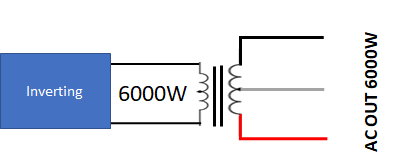I assumed it allowed for a large imbalances because of the transformer. I want to test this further. I’d like to get a hold of this inverter and check it’s tolerances.
The 6000EX is essentially a 240V HF inverter with an autotransformer to generate the neutral.

This is not the same as a traditional low frequency design, but it gives the unit some of the characteristics of a Low-Frequency design. The autotransformer will create slightly cleaner output, and do slightly better at handling short surge loads than the underlying HF frequency that is driving it. The load imbalance handling of the 6000EX is probably better than pure HF architecture, but I don't know if it would be as good as traditional LF architectures.
The large output transformers on the output of LF inverters are better at handling load imbalance, but *ALL* split-phase inverters have limits on the load imbalance. Even the utility transformer feeding your house has limits. You will never get the same wattage on one 120 leg as you can using both legs.
To understand why LF inverters are better at unbalanced loads, lets look at a hypothetical 6000W LF inverter.

The Full 6000 W is put into the primary coil of the transformer. If the transformer had 100% efficiency and no resistance, all 6000 W would be available on the 240V wires on the output. However, in the real world with inefficiencies and resistance, not all 6000W will make it through the transformer. The energy loss through the transformer will appear as heat in the transformer. As long as the transformer can dissipate enough of the heat energy, the transformer will not overheat and will continue operating. One of the big factors in the design to handle the heat will be the wire size and insulation on the secondary. Now lets us assume the engineer picked a wire size that exactly matches the need for 6000W at 240V... That means the wire is sized to handle exactly 6000/240=25A.
Now let's look at pulling all 6000 W from one leg of the transformer. This would be possible in the hypothetical loss-less transformer, but reality gets in the way. In order to deliver the full 6000W at 120V, it would have to deliver 6000/120=50A.... but remember the wire was only sized for 25A. So, in my hypothetical transformer with a secondary that can only handle 25A, each leg would be limited to only 3000W before damaging the secondary of the transformer. In real life, the transformers are designed with a safety margin on the capability of the secondary so they can handle an imbalance. How much imbalance is dependent on how much margin is built in. Theoretically, the transformer could be designed to handle the full 6000 W on one leg, but that would get very large and very expensive.
Now let's look at the typical design of a split phase high-frequency inverter:

This design can be thought of as two 3000W 120V, 25A inverters in series. In series, they add to 6000W at 240V and 25A.
With this design, only 3000W is available on each leg. In order to get more out of each leg, the inverter associated with that leg would have to produce it. So, in the extreme, if you want 6000W out of one leg, the underlying inverter for that leg would have to be able to handle 6000W..
If you wanted 6000W out of either leg, both inverters would have to be able to produce 6000W, so it would actually be a 12000W inverter.






